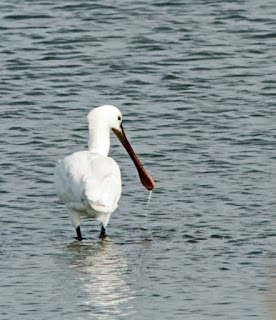We met at Keyhaven on a three quarter tide and as soon as we got out of our cars we had seven Bearded Tits flying into the reedbed next to the parking area, not waders but what a start! We took the shoreline path and immediately started with a number of Black-tailed Godwits, mostly adult birds but we managed to find a couple of youngsters to compare plumages. Here we also had Turnstone, Dunlin and Grey Plovers followed by Curlew and Redshank. Moving on round we came across a number of birders looking into a marshy field and found out that the Wryneck from the previous day had been seen. We gave it some time but it didn't show so we moved on to look for the Grey Phalarope on Keyhaven lagoon, though we hadn't gone far when Martin drew our attention to a Peregrine sitting on a post out in the saltmarsh on the seaward side.
Scanning Keyhaven Lagoon we added eight Pintail looking like they were freshly arrived and a flight of eight Wigeon flew over to the west. We were just viewing the Grey Phalarope at the far end of the lagoon before moving for closer views when another birder mentioned to us that the Wryneck was now showing. We turned on our toes and headed quickly back to look for this small woodpecker species. Very kindly one of the birders helped me to place my scope on the right spot so I could do the same for the rest of the group. It took a few minutes for it to show and then it popped up right on top of a small mound giving good views though a little distant, then it flew a short way and disappeared out of sight again. It was nice to get a life tick for a number of the group so everything else was going to be a bonus.
Scanning Keyhaven Lagoon we added eight Pintail looking like they were freshly arrived and a flight of eight Wigeon flew over to the west. We were just viewing the Grey Phalarope at the far end of the lagoon before moving for closer views when another birder mentioned to us that the Wryneck was now showing. We turned on our toes and headed quickly back to look for this small woodpecker species. Very kindly one of the birders helped me to place my scope on the right spot so I could do the same for the rest of the group. It took a few minutes for it to show and then it popped up right on top of a small mound giving good views though a little distant, then it flew a short way and disappeared out of sight again. It was nice to get a life tick for a number of the group so everything else was going to be a bonus.
Shortly after we were stood at the end of Keyhaven lagoon looking to see where the Grey Phalarope had gone, it was nowhere to be seen. I stepped as close to the drainage ditch as possible to look down the edge and it just popped up and flew directly towards us banking at the last minute and plopped down on the water just a few metres in front of us giving great views.
 |
| Grey Phalarope sequence shot as it passed us and landed on the water © Nick Hull |
Well, Jackie and I knew we weren't going to top that but the rest of the walk produced all the usual species we would usually expect to see and we added a couple of Spoonbill which were feeding on Fishtail lagoon.
We walked out to the point to see if there was anything out on the Solent and this gave us the opportunity to look at a number of Grey Plover that still retained most of their summer plumage. We had a few more Dunlin and Oystercatchers. We ended the day with 64 species and hopefully the group has a better idea of ageing waders.
 |
| Spoonbill - Fishtail Lagoon - Keyhaven © Nick Hull |
 |
| Grey Phalarope - Keyhaven Lagoon © Nick Hull |
I promised a couple of the group a link to the ageing of Grey Plover, and one to show waders that migrate via the Yellow Sea that shows what an important area it is for so many wader species or as they say on the video Shorebirds.







